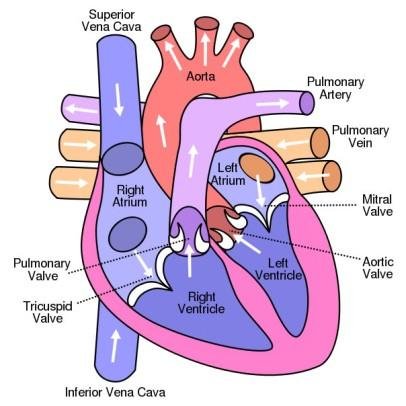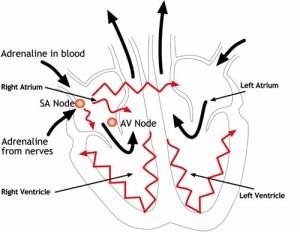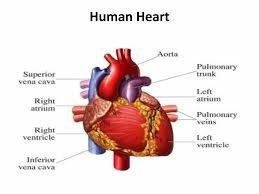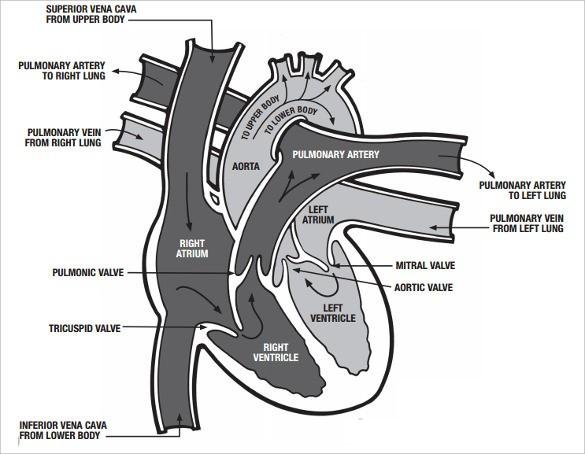STRUCTURE OF HUMAN HEART AND IT'S FUNCTIONS.
You have curiosity to know about the human heart. All curious persons want to know about Human Heart and its functions. This article will satisfy you to learn about the heart function in human body.
Actually no human or animal can be living without heart. The heart is a muscular organ in humans and in other animals. It pumps blood through the blood vessels of the circulatory system. It is amazing to learn about what a real human heart does. Blood provides your body with oxygen and nutrients, as well as assists in the removal of metabolic wastes. The human heart location is in the middle compartment of the chest. In order to understand all about the anatomy of the human heart and its functionality, firstly you should take a glimpse of diagram of a heart of human being as given below. This article will make you understand the location of human heart, it's functions, various heart diseases, their causes and solutions. Above all, reading this article will give you lot of information on the Human Heart and its functions. You will find lot of images side by side in the article which will help you recognize the reality of heart functions.
Human Heart image.

Source: Google.
FUNCTIONS OF HUMAN HEART
As you understand the location of heart in human body, now you will learn more on its functionality. Before going into detail description of human heart functions, you should take a glimpse of a human heart diagram as above. The above diagram shows the structure of a human heart. Please have a look at the article where you will find more informative images about human heart. Human heart has 4 chambers which are correlated with each other. The diagram also shows you different important parts of human heart, such as the aorta, pulmonary artery, pulmonary vein, left atrium,
Human heart diagram 1

Source: Google.
right atrium, left ventricle, right ventricle, inferior vena cava and superior vena cava among others.
LOCATION OF THE HEART.
Your heart is located in your chest, and your rib cage is supporting the heart from any hit coming outside of the body that can make an injury to the heart. Before knowing the function of human heart, you must have knowledge on different parts of your heart. Human heart has four chambers – the left atrium, right atrium, left ventricle and right ventricle. The heart has four valves as well because of its having four chambers. Flow of blood is controlled with these valves – blood can flow only one way, either in or out. The blood, leaving the heart, is carried through arteries to your body. The main artery, leaving the left ventricle, is the aorta while the main artery, leaving the right ventricle, is the pulmonary artery.
On the other hand, Blood flowing from your body towards heart through veins. Blood coming from the lungs to the left atrium is carried through the pulmonary veinswhile blood coming from your body to the right atrium is carried through the superior vena cava and inferior vena cava. If you have felt heat beating before, it is called Cardiac cycle.

Source: Google Animation
You might have watched television shows or movies where a patient in a hospital is attached to an electrocardiogram (ECG). You might recognize it as the machine with a line (image showing Purkinje fibers’ activities moving across a screen that occasionally spikes (or remains flat when a patient is dying). This machine can measure the electricity going through a patient’s heart. A doctor can use the information to know when a patient is having heart rhythm problems or even a heart attack. Heart attacks cause scar tissue to form amongst normal heart tissue of a heart of human being; this can lead to further heart problems or even heart failure. See the human heart diagram; take a glimpse of your heart structure.
HUMAN HEART DEPENDS ON ROLE OF HUMAN LUNGS TO BLOOD FLOW:
From above you have leaned about human heart blood flow and the basic of how the human heart works, but one thing was missing to be cleared i.e. the role of human lungs to blood flow. When blood travels through the pulmonic valve, it enters your lungs. It is called pulmonary circulation which is controlled by whole of the human heart system. Then from the pulmonic valve, blood travels to the pulmonary artery to tiny capillary vessels in the lungs. Here, oxygentravels from the tiny air sacs in the lungs, through the walls of the capillaries, into the blood. At the same time, carbon dioxide, a waste product of metabolism, passes from the blood into the air sacs. Carbon dioxide leaves the body when you exhale. Once the blood is purified and oxygenated, it travels back to the left atrium through the pulmonary veins.
Functions of left side and right side of human heart:
The diagram of heart shows that Left-Hand side and Right-Hand side of the real human heart have different functions, but they work together; lungs take part in the process of blood flowing as well. Functions of lungs are closely associated with the total human heart system.
FUNCTIONS OF LEFT SIDE OF HUMAN HEART:
The left-hand side of the heart receives oxygenated blood from the lungs through the pulmonary veins into the left atrium. Then the oxygenated blood passes through the bicuspid valve into the left ventricle. After that it is pumped to the aortaunder greater pressure. This higher pressure ensures that the oxygenated blood leaving the heart through the aorta is effectively delivered to other parts of the body via the vascular system of blood vessels.

Source: Google
FUNCTIONS OF RIGHT SIDE OF HUMAN HEART:
The right-hand side of the heart receives de-oxygenated blood from the body tissues (from the upper- and lower-body through the superior vena cava and the inferior vena cava, respectively) into the right atrium. This de-oxygenated blood passes through the tricuspid valve into the right ventricle. Then this blood is pumped under higher pressure from the right ventricle to the lungs via the pulmonary artery.
HOW DOES HUMAN HEART PERFORM ITS FUNCTIONS?
Pumping blood is your heart’s main function. The contraction and relaxation of the heart maintain the pumping function of the human heart. This contraction and relaxation goes with the continuous sequences. In order to know about human heart blood flow, you must have learnt about the terms “systole” and “diastole” which are the base of measuring your blood pressure. The “systole” indicates the contraction part and the “diastole” on the other hand, the relaxation part the sequences. So, when you are monitoring blood pressure it is easy way to measure the “systolic“ and “diastolic“pressures separately.

Source: Google
Here one thing is to be considered – how this sequence is initiated. Your nerve is liable for initiating this sequence. When your nerve impulses initiate a sequence, it governs the whole process of “systole” and “diastole.” It is called the alternating contractions and relaxations. This process can be whole series of actions that cause alternating contractions and relaxations may be reduced in the following 5 (five) steps:
The vagus nerve stimulates the sinoatrial node (SAN), the pacemaker of the heart. The sinoatrial node (SAN) is a tiny area of specialised cardiac (meaning “heart”) muscle in the upper wall of the right atrium, near the vena cava – as shown on the right.

Source: Google
Isolated heart conduction system, showing sinoatrial node (SA) node.This movement of the cardiac muscle pushes blood from the atria into the ventricles (via the tricuspid and bicuspid valves) of a heart of human.
The contractions of the atria send impulses down the Purkinje fibers, which in turn stimulate the atrioventricular node (AVN). The atrioventricular node is a mass of modified cardiac muscle located in the lower/central part of the right atrium of the heart.

Isolated heart condition system showing purkinje fibres activities.
Source: Google Animation.The action potential from the impulse transmitted down the Purkinje fibers reaches the right and left branches of the Purkinje fibres – as shown in the diagram on the right.
5.This causes the ventricles to contract, which pushes blood upwards into the arteries that take the blood away from the heart.
I have written this article to help you understand about Human Heart and its Functions so that you can be aware of reasons of some cardiovascular diseases (heart diseases) and take preventive measures accordingly. Among different heart diseases, the following two critical diseases are correlated with abnormal heart functionality.:
HEART ATTACK:
Heart attack happened when the flow of oxygen-rich blood to a section of heart muscle suddenly becomes blocked and the heart can’t get oxygen.
HIGH BLOOD PRESSURE:
The organs in your body need oxygen to survive. Oxygen is carried through the body by the blood. When the heart beats, it creates pressure that pumps blood through arteries and veins, also known as blood vessels and capillaries. The pressure (blood pressure) is the result of two forces:
a. The first force occurs as blood pumps out of the heart and into the arteries.
b. The second force is created as the heart rests between heart beats.
These two forces are each represented by numbers in a blood pressure reading. If your heart maintains normal heart beats, you are healthy & lucky.
However, from the above, you have got lot of information on the human heart which will enable you understand what situations are liable for heart diseases. You should remember that Human Heart and its functions tremendously impacts on your whole body.
Thank you you for reading.
REFERENCES:
Microsoft Corporation, Encarta Encyclopedia 2003.
www.heart.org
en.wikipedia.org